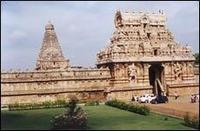Tanjore
 Tanjore Paintings, Brahadeeshwara Temple, Tamil literature, Paddy fields….this is Tanjore for all of us. Tanjore is originally Tanjavur in Tamil. The British could not pronounce the name, and made in Tanjore…which is its anglisized version. Tanjore is in the Cauvery river delta, with rich alluvial soil, making it the Granary of the South. Needless to say, Rice is chief crop that is cultivated by the people here.
Tanjore Paintings, Brahadeeshwara Temple, Tamil literature, Paddy fields….this is Tanjore for all of us. Tanjore is originally Tanjavur in Tamil. The British could not pronounce the name, and made in Tanjore…which is its anglisized version. Tanjore is in the Cauvery river delta, with rich alluvial soil, making it the Granary of the South. Needless to say, Rice is chief crop that is cultivated by the people here.If you see today, Tanjore is like any other sleepy town in TamilNadu. The two main attractions are the Bhradeeshware Temple and the world famous Tanjore paintings. Tanjore has about 93 temples, and most of them were built by Raja Raja 1 – the Chola Emperor, and was the capital of the Chola Dynasty from 9th to the 13th Century. It was the center of learning, culture and architecture.
I went to Tanjore by bus, from Trichy. It is a 40 minute ride in the local buses. Tanjore is a very important city in Tamilnadu, and hence it is well connected from all places, by buses and trains.
The Bhrahadeeshware temple and Fort in Tanjore is a World Heritage Site. It is very beautiful. This temple stands inside a fort, and hence has huge walls with monstrous entrance gate, watch towers, and also has a moat. It seems, during war times, people of Tanjore hid inside the temple fort, and the doors were closed.
Chola emperor Raja Raja I – The sailor king of India, (AD 985 - 1012), built it in 1010, just a few years before the Kajuraho temple was completed. Raja Raja 1, ruled most of Tamilnadu at that time. Appropriately called Brihadisvara and Daksinameru, this famous Saiva temple was inaugurated by the emperor himself in his 19th regal year (AD 1009-10) and named it after himself as Rajesvara Peruvudaiyar. It has the reputation of being the most ambitious structural temple built of granite ever. The fort like features, were added later during the 16th century. This monument is a culmination of temple architecture of the Dravidian style. Raja Raja was deeply involved in the temple construction, and hence one can find several inscriptions in the temple basement, in praise of the King.
The temple has its entrance in the East. As per Vasstu shastra, a East facing entrance was the best. The entrance gate has a huge vimana or gopuram. This entrance structure is aligned to the inner temple itself. The sanctum sanctorum has the hugh Shiva Linga.
This temple is beautiful and is an architectural marvel in more ways than one. It has a pyramid or vimana, which is 70 metres high, and is done in such a way, so that the shadow of the vimana does on fall on the ground at any point of the day.
There are smaller temples for Lord Subrahmanya, Lord Ganesha and Lord Nataraja ( the Dancing form of Lord Shiva ). Shiva’s vahan, the Nandi’s ( Bull ) shrine is right in front of the Shiva temple.
There are many cute stories attached to the Nandi here.
It seems several years ago, during the time of Kings, there was no rain at all. People prayed to Lord Shiva, but the prayers were not answered. The situation was getting grim. People assumed that the Lord must be in deep penance, and hence their prayers did not yield any response. They felt that the only way to get his attention was by tormenting him. The Nandi was very dear to the Lord. So, the people of Tanjore, applied lots of pepper powder on Nandi’s back. As time went by, Nandi could not tolerate the burning sensation on his back, and began to run helter skelter. Nandi’s cries woke up the Lord. The only solution that Lord Shiva had was to pour water on Nandi’s back to reduce the burning sensation, and relieve Nandi of the problem. It started pouring rain like never before, and the people of Tanjore were pleased.
After this, it became common practise at Brihadishwara temple, that all those who came to Worship Lord Shiva, went to Nandi, and repeated all the prayers into its ears. The reason being, if the Lord was in penance, then he would not yield, then Nandi would remind him. Interesting isn’t it.
The Palace was built partly by the Nayaks of Vijayanagar in 1550 AD, and partly by the Marathas. Adjacent to the temple the palace is a series of large and rambling buildings of fine masonry.
Tanjore paintings are very famous. It is a unique art, where images of Hindu Gods and Goddesses are drawn and also mythological characters. Gold leaf and precious stones are used in the paintings to make the jewelry and the clothing of the gods and Godesses depicted. Therefore, Tanjore paintings are very expensive.
How to get there :
By Air : Trichy – 65 Kms. Madurai – 200 kms. Chennai – 350 kms
By Rail There is a railway junction in Thanjavur. It's well connected with Trichy, Chennai and Nagore.
By Road Thanjavur is well linked with all the major towns in Tamil Nadu and is also connected with Kochi, Ernakulam, Thiruvananthapuram and Bangalore.
Trip duration : 2 days
Best time to travel : Throughout the year
Accomodation :
Oriental towers hotel, 2889, Srinivasam Pillai Road, Thanjavur
Parisutham Hotel, 55 Grand Anicut Canal Road, Thanjavu
Sangam Hotel, Trichy Road, Thanjavur

<< Home